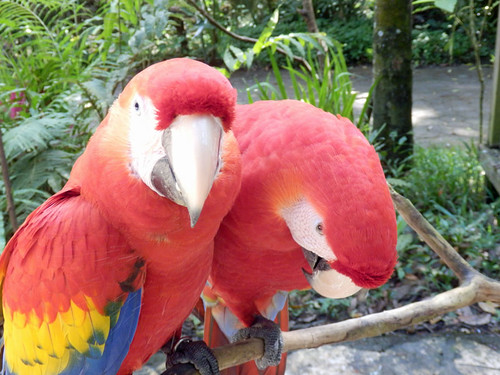 Scarlet macaws reintroduced at Copán archaeological siteAmid the ancient city, now a weathered imitation of its former glory but still doused in force and grandeur, a series of stony heads catches the eye. They line the court where the ancient Mayan ball game was played. Nobody really knows what the rules were, only that it often took on a literal life or death importance that makes baying football crowds look tame. The competitors were sometimes sacrificed as an offering to the gods afterwards.
Scarlet macaws reintroduced at Copán archaeological siteAmid the ancient city, now a weathered imitation of its former glory but still doused in force and grandeur, a series of stony heads catches the eye. They line the court where the ancient Mayan ball game was played. Nobody really knows what the rules were, only that it often took on a literal life or death importance that makes baying football crowds look tame. The competitors were sometimes sacrificed as an offering to the gods afterwards.
The stone heads are not human, however. They’re of scarlet macaws, which would have had a near ubiquitous presence in Copán during its era of greatness between the 5th and 9th centuries AD. The Mayans regarded the scarlet macaw as sacred, with its flamboyant tail feathers often used as decorations for the costumes of the kings. But until recently, the bird’s attention-grabbing squawky cries had as good as disappeared.
People come to Copán – in western Honduras – to see the extraordinary ruins. But on the way to the main plaza, they now have to pass through a gauntlet of noise and bright feathers. A feeding station and release aviary has been placed by the ancient site. And it’s all part of a bid to bring back Honduras’ national bird to an area where it had almost disappeared.
Loss of habitat had been a major factor in the scarlet macaw’s decline, but people (illegally) keeping them as pets was also critical. And most of the birds being released to fly free over the ancient ruins are the offspring of these rescued pets.
The breeding takes place amongst the tropical gardens of Macaw Mountain, a privately funded venture in a former coffee plantation a few kilometres away. “Part of the problem is that the macaws are monogamous,” says Macaw Mountain’s José Antonio Martinez. “If one is taken as a pet, the other doesn’t find a new mate.”
Some of the rescued birds are in heartbreaking state – they’d been kept in cages too small, and the stress had let to them trying to clip their own wings or pull out their own feathers. Most wouldn’t survive in the wild, and Macaw Mountain is effectively a retirement home.
But from the rag-tag bunch of misfits, four breeding pairs have been matched. Since 2011, twenty of their offspring have been kept safe in the park, then given special training and released. It’s hoped that these will in turn start breeding with the few wild birds left around the ruins.
“Looking after them here gives them a better chance of survival,” says Carlos. “They’ll have four to eight chicks here, most of which will make it. In the wild, perhaps two will survive – there are plenty of predators for which they make an easy feed.”
The fully grown macaws are a different matter, however. Few birds manage to look so elegant yet so handsome at the same time. At Copán, they seem to have a strutting confidence about them. Some aren’t quite ready to fly free yet, but the aviary and feeding station are the last steps before they will fly off and soar freely over the place where the great ancient civilisation regarded them with such reverence.